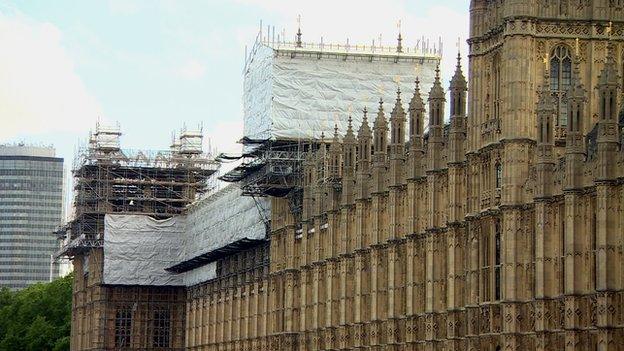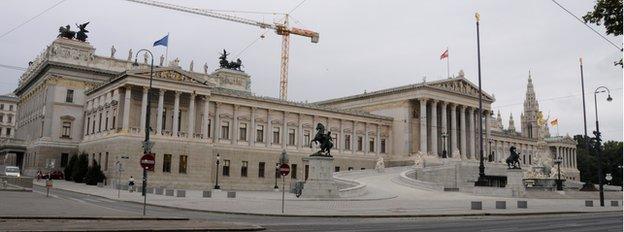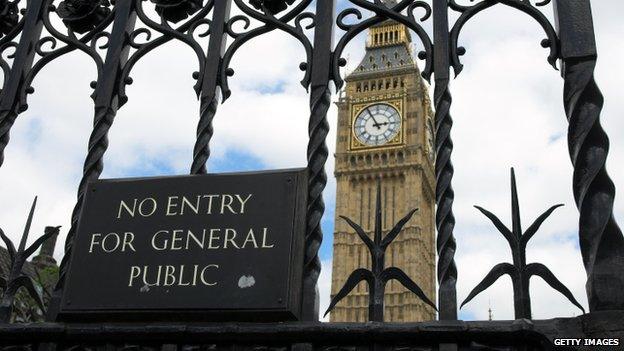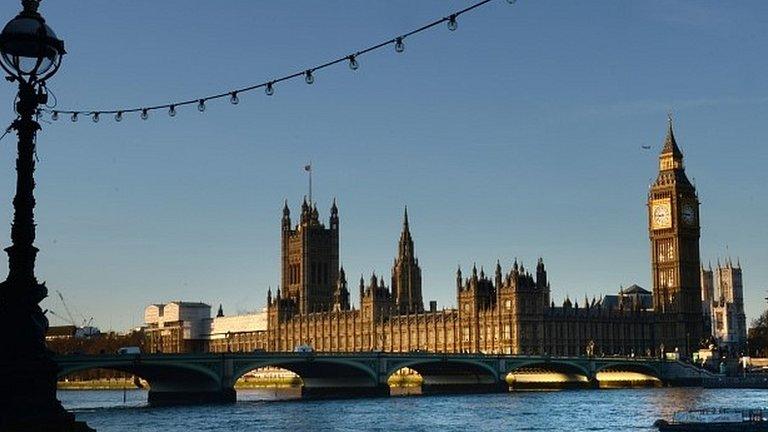Parliament crumbles: Saving the Palace of Westminster
- Published

Rats crawling around. An infestation of moths. Effluent leaking through the floors.
This scene of devastation is hardly the image that springs to mind when most people think about the Houses of Parliament, but the architectural masterpiece is crumbling in its old age.
Some of the worst damage is on the famous skyline and in the decaying stones that are being weathered away.
But perhaps more worrying is the suggestion that the tower often referred to as Big Ben, could becoming more like the Leaning Tower of Pisa.

What are the options?

According to the Independent Options Appraisal report, external, if MPs and peers choose not to move out at all, the work on the Grade I listed building is projected to last between 25 and 40 years at a cost of £5.7bn with users of the palace having "to tolerate high levels of disruption and disturbance over a long period"
Moving politicians out for about six years, the cost would drop to £3.5bn and developments could include a lift up the Elizabeth Tower, a media centre for TV interviews and "increased breakout, formal and informal meeting areas" for those who work in the Palace of Westminster
The report also has two halfway-house options - carrying out basic repairs such as improving fire safety and removing asbestos with a partial vacation of parliament or a higher-spec version of repairs also with politicians moving in and out in stages. These options would most likely last 11 years
If MPs were to move out temporarily, some experts have speculated that a new building may need to be constructed in order to be suitable for a modern parliament

'Magic quality'
Adam Watrobski, principal architect at the Houses of Parliament, told BBC Newsnight that "there is a problem with the building moving".
"Some of the facades are actually sinking and we're going to have to investigate that very soon," he said.
"It's not sinking very fast as far as we can see, but it certainly warrants investigation."
There are also problems including asbestos, hazardous wiring and an infiltration of rodents that all need urgent attention.

The collection of buildings, courtyards and passageways cover eight acres on the banks of the River Thames, with more than 1,000 rooms and three miles of corridors that have already dealt with their fair share of disaster.
Originally built on the site of William the Conqueror's first palace, the Houses of Parliament were left severely damaged by a fire in 1834 and were then rebuilt as a Gothic fantasy palace.
The landmark was also bombed 14 times during World War Two.
But even in these worst of times the politicians who occupied the premises never moved out completely.
Journalist Michael Cockrell, who spent a year filming inside parliament for his BBC series Inside the Commons said almost everyone he spoke to "revered the place and its magic quality".
"It's an extremely significant place and so much of our history has played out there.
"A prime minister assassinated, a king sentenced to death, a world war defeated.
"After WW2 Winston Churchill himself said it should be rebuilt exactly as it was saying, 'We shape our buildings, and afterwards our buildings shape us.'"

Moving house

The UK is not the first country to face the challenge of a deteriorating parliament building.
At more than 130 years old, the dramatic neo-classical Austrian parliament in Vienna suffers from leaky roofs and poor ventilation. While it undergoes renovation, proceedings have been moved to the Hofburg palace, also home to the renowned Spanish Riding School.
Parliament Hill in Ottawa, Canada, built from 1859, with its similar neo-gothic design and green upholstered Houses of Parliament, has experienced some of the same problems with crumbling masonry and asbestos.
It is currently undergoing what one MP described as "the mother of all renovations" with a £3bn price tag, phased over 20 years. Parliamentarians have been moved to temporary offices in Ottawa.
The parliamentary renovation team could also look closer to home for ideas on finding temporary shelter.
While the Scottish Parliament's permanent building at Holyrood was being constructed between 1998 and 2004, its home was the General Assembly Hall of the Church of Scotland on the Royal Mile in Edinburgh. It also made stops at the Strathclyde Council's former premises and the University of Aberdeen.

'Real opportunity'
With more than 10,000 pass holders using the building experts are warning it will be one of the most complicated restoration projects ever attempted and may only be achievable if MPs and peers de-camp for a while.
Labour MP Graham Stringer thinks the Palace of Westminster has finally had its day and now is the time for a new parliament to be built - outside the capital.
"It's a real opportunity not just to move out for four or five years but an opportunity to make a break with London. I think somewhere like Manchester would be much more appropriate. It would be an economic boost for the city and the buildings in Westminster would be able to generate much more from their commercial value being let out and made into tourist attractions."
And he's not alone in his views.
Campaign group Generation Rent have suggested that parliament moves to Hull and the Palace of Westminster be turned into affordable housing, saving the taxpayer £120m per year.
But Conservative MP Sir Alan Duncan said it was "a ridiculous idea" to suggest politicians should move anywhere but Whitehall.
"It is utterly impractical to move out of London," he said.

Readers of the BBC News website had their views on the options.
Nick Smith, from Luton, emailed to say: "While I am in favour of tradition and ceremony, and it's good for the tourist trade - it really is time for 'The Mother of Parliament' to enter the modern era.
"A new purpose-built building with every conceivable hi-tech gadgetry to aid in the running of this country would be more viable than spending up-to 3 billion quid on preserving the old building."
Tony Watson from Cambridgeshire wrote: "Construct a new well-planned Parliament complex possibly in the Leicester or Birmingham area. More central for all politicians. Then move the politicians out of Westminster and renovate the old building. Make that wonderful site a museum of British politics."
Craig Robinson tweeted that the restoration "would be worth every penny" while Andrew Bulman said: "Instead of demolishing Earl's Court, why not fit it out as a temporary parliament while Westminster is repaired and refurbished?"
The Commons and Lords will have to vote in the next few years on what to do next.
But every day that a decision is not made, the fabric of the building crumbles a little more.
- Published18 June 2015

- Published18 June 2015

- Published20 November 2014
